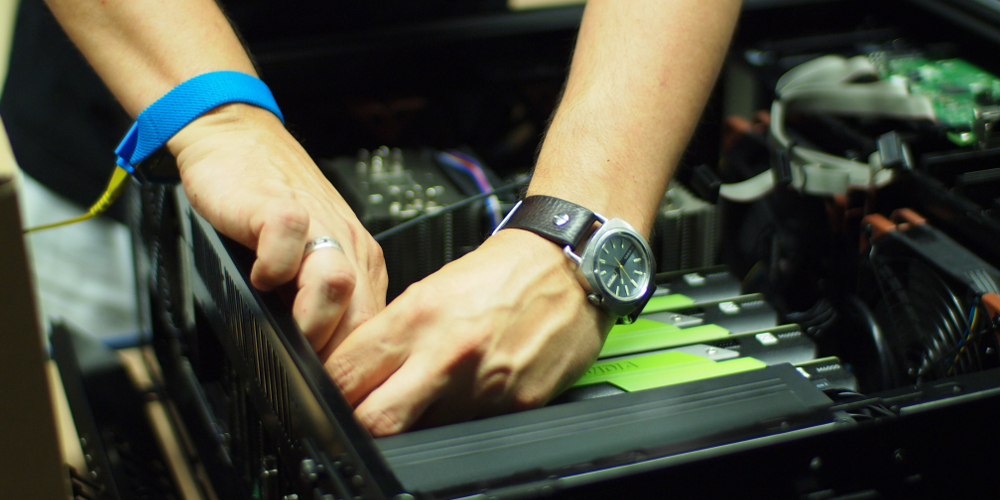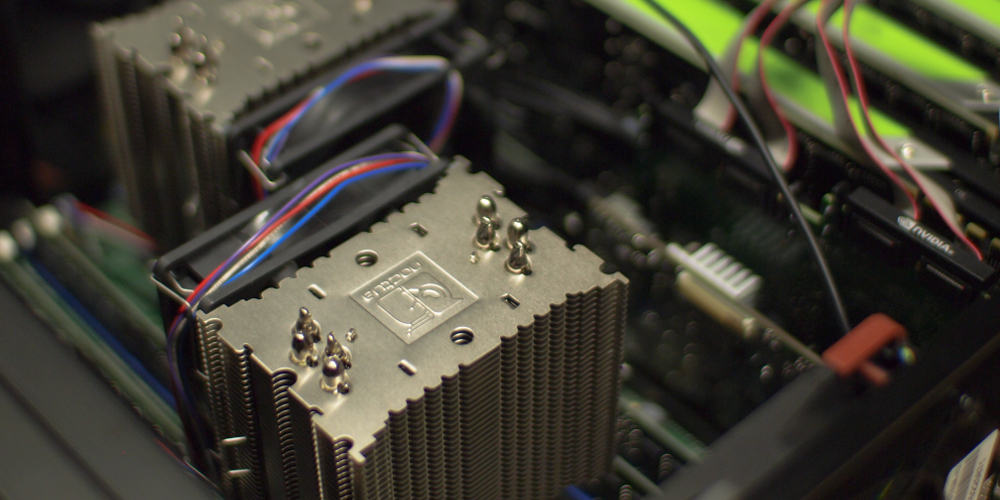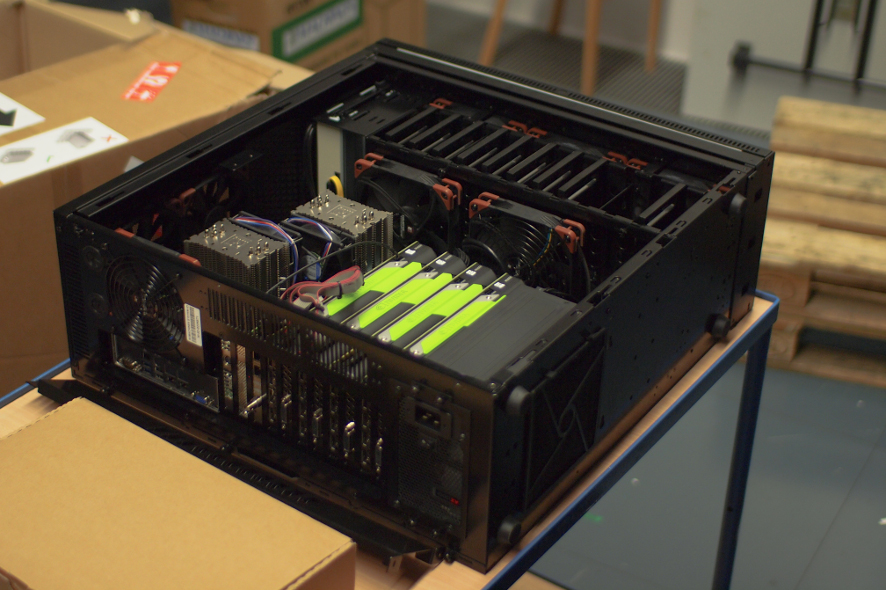The new Deep Space opens on August 7, 2015! In Deep Space 8K, visitors can look forward to breathtaking visuals in 8K resolution on 16×9-meter projection surfaces on the wall and the floor. This means that each individual image consists of 8,192 × 4,320 pixels. The bottom line: crystal clarity. In contrast to a commercially soon available 8K UHD TV set, Deep Space’s bank of eight 4K projectors achieve a mind-boggling 120 Hz and not just a measly 30 Hz. And processing the resulting flow of data — an awesome 23 gigabytes/second in real time — demands a special high-performance processor. A long, intensive search brought the Deep Space 8K crew to XI-MACHINES.
In this interview, XI-MACHINES Managing Director Patrick Strenge talks about the new supercomputers.
Mr. Strenge, we had to search long and hard before we came upon the high-performance processors manufactured by XI-MACHINES. How are these processors deployed normally?
Patrick Strenge: XI-MACHINES high-performance systems like the COMPUTE CX4 are used in situations that call for the ultimate in reliable computing power. The CX4 is deployed in a variety of areas: simulations, science and R&D involving complex mathematical calculations, or in the field of education—for instance, in the so-called Deep Learning sector. As a result of the latest developments in processor & graphic card technology, our CX4 workstations are also especially well suited to 3-D visualizations in real time for presentations such as events, live remote transmissions or classic broadcasting operations. Our high performance computing (HPC) workstations are also frequently used in the auto industry in order to depict complex models in their actual dimensions as realistically as possible and, above all, without time delay to thus more quickly and easily assess the results of modifications. That’s why we’re proud to say that our systems are currently in use worldwide in a wide array of prestigious projects by top-name broadcasting companies, car manufacturers, universities and theaters.

Put your high-performance processor in perspective for us — how does it compare to a typical computer like the one I use in my office?
Patrick Strenge: Hard to believe, but our CX4 is truly a supercomputer! Consider this: in the mid-’90s, the world’s second-fastest supercomputer at the National Aerospace Laboratory in Tokyo, Japan achieved total computing capacity of 170 gigaflops using 166 processors, which was quite a lot at the time. Now, the processing power of a single CX4 workstation is approximately 25,000 gigaflops!
To match the enormous processing power of a single CX4, the unit that’s used in Deep Space 8K, you would need about 200 conventional PCs! In fact, two CX4s are used in Deep Space 8K to produce the synchronized projections on the wall and the floor. So that means that approximately 400 run-of-the-mill PCs would have to installed and put into operation. Strictly in terms of space, you would need quite a large room instead of two workstations. I think that paints an impressive picture of the output of our CX4 high performance computing systems.
It’s always been necessary to compromise: either a computer works fast and loud, or soft and slow. How did XI-MACHINES resolve this issue?
Patrick Strenge: Our engineers succeeded in achieving a real balancing act—both high performance and very-low-noise operation—by combining components we developed in-house and performing a huge number of system tests. Instead of making compromises in the production process at the cost of system stability, we opted to get to the root of the noise problem. That’s what enables XI-MACHINES high-performance workstations to operate almost silently right in the workplace instead of having to banish it to a separate room, with the waste of space that entails. For example, the workstations in our X3 model series are the softest-running workstations on the market worldwide. Even when the system’s working at maximum capacity, the only way to tell it’s even turned on is to see whether the blue LED indicator is lit up. Users can concentrate on their creative work without having to fear that compromises have to be made with respect to output and system stability.

At present, 1 gigabyte of storage capacity is provided by a module about the size of two credit cards, whereas 30 years ago, the requirements were 700 square meters of space and enough electricity to power a small town. How do you see this development proceeding in the future?
Patrick Strenge: A surface of about 45 square centimeters—approximately corresponding to the size of a state-of-the-art server memory module—is already sufficient for 64 gigabytes of memory storage capacity! That’s pretty impressive. This trend towards miniaturization will continue—what technology currently permits and beyond that. For example, 65 nanometer technology used to be used in production; today, it’s down to 10 nanometers. In my opinion, human beings incessantly strive for more. And if that “more” doesn’t exist at present, then research focuses on possible ways to ultimately achieve it. I think that this behavior is part of human nature. We at XI-MACHINES are no exception. Our teams are constantly searching for ways to reach the limits of technical feasibility and then to expand those limits—provided that reliable, continuous operation is possible.
The European Commission will be providing €1.2 billion in subsidies to the Human Brain Project over the next 10 years. One of this project’s objectives is to manufacture computers modeled on natural nerve networks. Will machines soon be as intelligent as human beings?
Patrick Strenge: It depends on how you define intelligence. I’m absolutely convinced that the processing power of computers will someday be enhanced to the point that it will surpass the human brain as far as pure computational output is concerned. Just look at what’s happening in the field of quantum computing. This is opening up totally new approaches to dealing with current and future problems. Nevertheless, I personally like to differentiate between machine intelligence and human—in the literal sense—intelligence. The way I see it, pure binary computational power will never even come close to simulating the human mind. The human spirit consists of an inimitable combination of “analog” knowledge, emotions, experience, empathy and much more, and this is what makes a human being a unique creature. This entire ensemble can’t be emulated digitally. Fortunately! No matter how powerfully efficient future computer systems get, in my opinion, human beings should still always have the final say in momentous, far-reaching decisions.

One final question: What’s the average life expectancy of a supercomputer, actually?
Patrick Strenge: That’s highly dependent on its area of deployment. Many supercomputers have remained in service for decades since they can still do the job they were meant to do. In research fields, as a rule, high-performance computing workstations are upgraded frequently. The average time it takes for a machine to have to be replaced is about 2-4 years. The beautiful thing about an HPC workstation from XI-MACHINES is that it can be used for a very long time. What we’ve seen is that our clients purchase one or more systems for their most important workplaces and then already replace them after two years. But the replaced systems aren’t simply junked; they’re redeployed in other departments, whereby they’re demoted a level in the so-called processor hierarchy. So there are many instances in which our workstations remain in service over a period of 5-8 years. During their useful life, they do their job reliably, inconspicuously, quietly, like a dumb waiter, and then they’re put out to pasture for a well-deserved retirement. So, an investment in solidly developed hardware always makes sense.
The opening of the Deep Space 8K is n August 7th at 6:00 PM. On the subsequent opening weekend, Saturday & Sunday, August 8-9 from 10 AM to 6 PM, the Deep Space 8K starts an extensive program: https://ars.electronica.art/center/en/eroeffnungswochenende-deep-space-8k/
